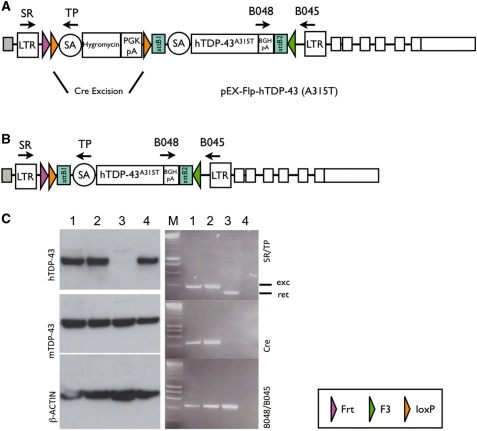Figure 4.
In vivo excision of the hygromycin-resistance cassette. (A) The gene trap vector rFLPRosabetageo, which was inserted in intron 1 of the mouse Tardbp gene (clone D045A10 in Fig. 2), was replaced by pEx-FLP-hTDP-43(A315T). A mutant mouse line with this genomic modification was established and crossed with Rosa26-Cre deleter mice. (B) The RMCE allele in the mouse Tardbp intron 1 after Cre-mediated excision of the hygromycin-resistance cassette. (C) Left: total protein was extracted from embryonic heads (lanes 1–3), after mating to Cre-deleter mice at E17.5 or HEK293 cells (positive control, lane 4). Three western blots were done in parallel using antibodies against human Tdp-43 (hTDP-43), human and mouse TDP-43 (mTDP-43) and β-actin. TDP-43 runs at ∼45 kDa, β-actin runs at 42 kDa. Right: DNA for genotyping was obtained from tails. PCR was performed using the primers SR/TP or B048/B045 as depicted in (A). The presence of Cre was detected using primers specific for Cre-recombinase. Exc: excision (of the hygromycin-resistance cassette); Ret: retention (of the hygromycin-resistance cassette). LTR: long terminal repeat, SA: splicing acceptor, PGK-pA: phosphoglycerate kinase poly A signal; BGHpA: bovine growth hormone polyA signal; attB1/2: gateway clonase recognition sites.

